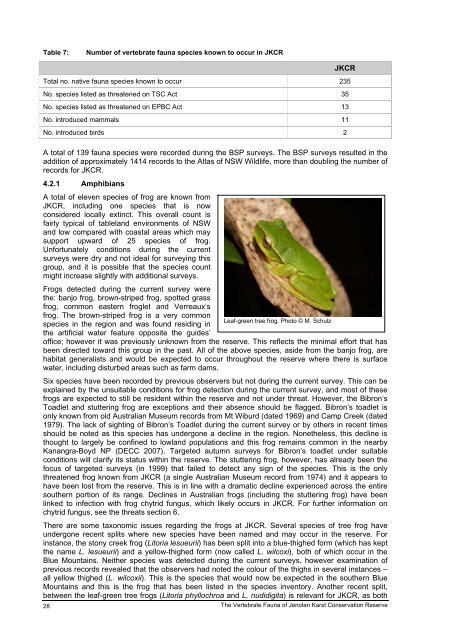The Vertebrate Fauna of Jenolan Karst Conservation Reserve: Final
The Vertebrate Fauna of Jenolan Karst Conservation Reserve: Final
The Vertebrate Fauna of Jenolan Karst Conservation Reserve: Final
Create successful ePaper yourself
Turn your PDF publications into a flip-book with our unique Google optimized e-Paper software.
Table 7: Number <strong>of</strong> vertebrate fauna species known to occur in JKCR<br />
28<br />
JKCR<br />
Total no. native fauna species known to occur 235<br />
No. species listed as threatened on TSC Act 35<br />
No. species listed as threatened on EPBC Act 13<br />
No. introduced mammals 11<br />
No. introduced birds 2<br />
A total <strong>of</strong> 139 fauna species were recorded during the BSP surveys. <strong>The</strong> BSP surveys resulted in the<br />
addition <strong>of</strong> approximately 1414 records to the Atlas <strong>of</strong> NSW Wildlife, more than doubling the number <strong>of</strong><br />
records for JKCR.<br />
4.2.1 Amphibians<br />
A total <strong>of</strong> eleven species <strong>of</strong> frog are known from<br />
JKCR, including one species that is now<br />
considered locally extinct. This overall count is<br />
fairly typical <strong>of</strong> tableland environments <strong>of</strong> NSW<br />
and low compared with coastal areas which may<br />
support upward <strong>of</strong> 25 species <strong>of</strong> frog.<br />
Unfortunately conditions during the current<br />
surveys were dry and not ideal for surveying this<br />
group, and it is possible that the species count<br />
might increase slightly with additional surveys.<br />
Frogs detected during the current survey were<br />
the: banjo frog, brown-striped frog, spotted grass<br />
frog, common eastern froglet and Verreaux’s<br />
frog. <strong>The</strong> brown-striped frog is a very common<br />
Leaf-green tree frog. Photo © M. Schulz<br />
species in the region and was found residing in<br />
the artificial water feature opposite the guides’<br />
<strong>of</strong>fice; however it was previously unknown from the reserve. This reflects the minimal effort that has<br />
been directed toward this group in the past. All <strong>of</strong> the above species, aside from the banjo frog, are<br />
habitat generalists and would be expected to occur throughout the reserve where there is surface<br />
water, including disturbed areas such as farm dams.<br />
Six species have been recorded by previous observers but not during the current survey. This can be<br />
explained by the unsuitable conditions for frog detection during the current survey, and most <strong>of</strong> these<br />
frogs are expected to still be resident within the reserve and not under threat. However, the Bibron’s<br />
Toadlet and stuttering frog are exceptions and their absence should be flagged. Bibron’s toadlet is<br />
only known from old Australian Museum records from Mt Wiburd (dated 1969) and Camp Creek (dated<br />
1979). <strong>The</strong> lack <strong>of</strong> sighting <strong>of</strong> Bibron’s Toadlet during the current survey or by others in recent times<br />
should be noted as this species has undergone a decline in the region. Nonetheless, this decline is<br />
thought to largely be confined to lowland populations and this frog remains common in the nearby<br />
Kanangra-Boyd NP (DECC 2007). Targeted autumn surveys for Bibron’s toadlet under suitable<br />
conditions will clarify its status within the reserve. <strong>The</strong> stuttering frog, however, has already been the<br />
focus <strong>of</strong> targeted surveys (in 1999) that failed to detect any sign <strong>of</strong> the species. This is the only<br />
threatened frog known from JKCR (a single Australian Museum record from 1974) and it appears to<br />
have been lost from the reserve. This is in line with a dramatic decline experienced across the entire<br />
southern portion <strong>of</strong> its range. Declines in Australian frogs (including the stuttering frog) have been<br />
linked to infection with frog chytrid fungus, which likely occurs in JKCR. For further information on<br />
chytrid fungus, see the threats section 6.<br />
<strong>The</strong>re are some taxonomic issues regarding the frogs at JKCR. Several species <strong>of</strong> tree frog have<br />
undergone recent splits where new species have been named and may occur in the reserve. For<br />
instance, the stony creek frog (Litoria lesueurii) has been split into a blue-thighed form (which has kept<br />
the name L. lesueurii) and a yellow-thighed form (now called L. wilcoxi), both <strong>of</strong> which occur in the<br />
Blue Mountains. Neither species was detected during the current surveys, however examination <strong>of</strong><br />
previous records revealed that the observers had noted the colour <strong>of</strong> the thighs in several instances –<br />
all yellow thighed (L. wilcoxii). This is the species that would now be expected in the southern Blue<br />
Mountains and this is the frog that has been listed in the species inventory. Another recent split,<br />
between the leaf-green tree frogs (Litoria phyllochroa and L. nudidigita) is relevant for JKCR, as both<br />
<strong>The</strong> <strong>Vertebrate</strong> <strong>Fauna</strong> <strong>of</strong> <strong>Jenolan</strong> <strong>Karst</strong> <strong>Conservation</strong> <strong>Reserve</strong>

















